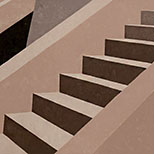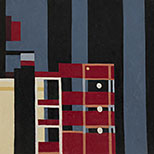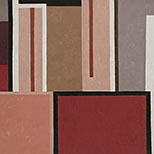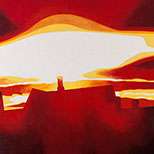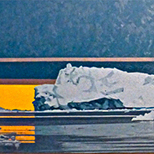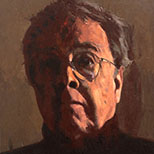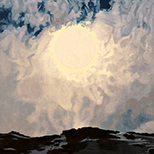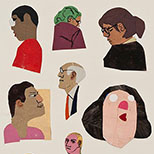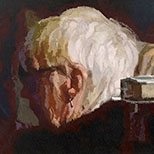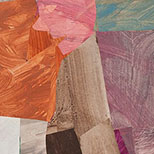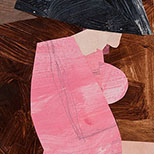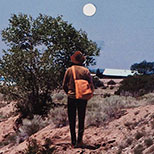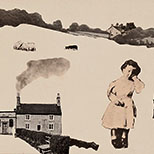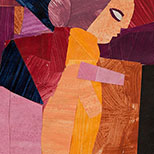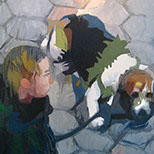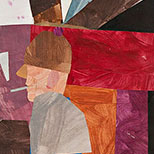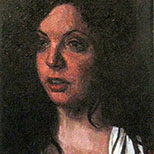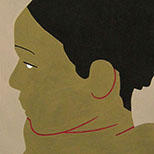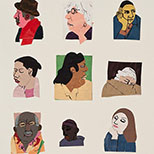
Roger Winter
Essay by Susie Kalil
Roger Winter's extraordinary, hauntingly beautiful paintings of the mundane and unobtrusive pay close attention to subjects seen on the quick, in a glimpse. The works at KHFA show this former Dallas artist's continued commitment to the precise rendering, the studied demarcation and incongruities of sections of the natural world and the manmade—sections that may seem, to the casual viewer, differentiated in an arbitrary way. Yet all of the landscapes and portraits are rendered as if by virtue of a stare that never seems to end. Winter captures the spirit of diverse locales and environments, from arid plains of West Texas and snowy fields of rural Maine, to congested intersections of New York City. But to say that Winter is a simple-minded realist is to miss all the ways that he fuses precise observation with structural rigor and painterly sensuality. Indeed, Winter's meticulous attention to the appearance of things and their capacity for mysterious drama yields lyric passages that evoke feelings of transcendence.
There is always a deep sense of quiet in a Winter painting—of breath both held and released. His art is balanced between abstraction and realism, not because he moves from one to the other, but because he has found a space between the two. The representational elements of a Winter painting act not only as signifiers of the outside world, but also as pretexts for the physical act of painting and as templates for viewing. They demand a scanning, allover read. But by keeping the images close to the surface, they maintain the flatness of the picture plane while allowing us the pleasures of mental contrast or a Modernist flip-flop between material surface and illusory depth. Spaced more or less evenly over the surface, edge to edge, the pictorial incident invites a slow look. To experience one of Winter's paintings is to feel simultaneously the sudden reality of a specific place as well as the slow passing of time.
A prevailing notion of landscape painting implies that the artist must capture some likeness of a certain geographic locale. To render a sense of place, an artist should have a kind of primitive earth-consciousness of his native region. For Winter, the understanding of place includes but goes beyond the local, but also of the larger, universal implications of what has been discerned in a given "place." Winter has the courage and intelligence to inform his work with what he sees and feels. He is intensely aware of his surroundings and responds to the shifting narratives with an acutely critical, objective observation, as well as a highly intuitive sense which sometimes borders on an understanding beyond a merely physical reality. Toward that end, Winter's investigation is often framed within the context of a journey at once literal and allegorical, whose changing landscape continuously challenges the very limits of perception and consciousness. Flowing associatively, Winter's images traverse a strange yet hauntingly familiar territory that evokes the realm of dreams, memory and the imagination—those often subliminal and turbulent layers of experience in which the potential for self-discovery and renewal reside.
Winter has always been an artist of tenacity, deeply conscious of the tradition he works in and the homages to other art that it entails. His work has changed considerably as it has developed over the decades, demonstrating the artist's capacity for continuous self-criticism and awareness rarely matched by his contemporaries. Winter comprehends the nature of art at its most fundamental as a mutating, vibrant and evolving force. To many viewers, however, Winter's landscapes and portraits represent the re-embrace of bygone values sorely missed in painting today. Their fine qualities of light, craft, surface, form and space blow fresh air into the lungs of an audience seeking the wholeness of a unitary visual expression. Still, the successful bodies of work that Winter has produced during his career do not so much "develop," one from the previous, as loop back and branch out, so each body of work cleans new visual space adjacent to the next. Accordingly, Winter's earlier works may be taken as clearing a visible field for the later landscapes. Throughout, he celebrates the everyday miracles that only paint can achieve, miracles that come from attention to and engagement with the materials at hand. His art is as much a form of behavior as a product of poetry and craft. All in all, Winter's finely tuned paintings, animated by contrasting forces of palette and structure, seem alternately Spartan and generous. It's as if radiant energy has been collected between the tufted and skittering, staccato dabs of paint. One moves from the sharp contour of paint to the large masses of forms, weaving in and out of flickerings of light, which bring one back to the palpable vehicle of paint. The whole effect is sumptuous and absorbing. Nature is visible here, albeit in hiding; it is simultaneously close and distant, encompassing and eluding. The philosophical questions that emerge from these compositions deal with the mystery and enigma of our identity and existence, our solitary state in the world, our limits in space and time, our desire for the infinite.
Solo exhibition: Upper West Side+
Solo exhibition: Stories from Memory
Solo exhibition: Dallas Collects Roger Winter
Group exhibition and curation: One Plus One Equals Three
Two-person exhibition: Lois Dodd | Roger Winter
Solo exhibition: Cygnus: Paintings of Greenland, Iceland, and Sweden
Three-person exhibition: Monumental Works
Curated: A Transfer of Spirit: A Selection of Artists Who Studied with Roger Winter
Solo exhibition: Collages: 1968-2012, Portraits: 2013
Solo exhibition: Between Heaven and Earth
Education
1960: Max Beckmann Memorial Scholarship, Brooklyn Museum School, New York
1960: Master of Fine Arts, University of Iowa
1956: Bachelor of Fine Arts, University of Texas, Austin
Selected solo exhibitions
2011: Gerald Peters Gallery, Santa Fe, New Mexico
2008: Museum of Geometric and Madi Art, Dallas
2007: Dallas Center for Contemporary Art, Dallas
2005: Meadows Museum of Art, Dallas
2002: Pillsbury/Peters Fine Art, Dallas
2001: Biddeford Pool Fine Art, Biddeford Pool, Maine
2000: Artists' Gallery, San Antonio
2000: Edith Baker Gallery, Dallas
Selected bibliography
2007: "Roger Winter: Painting 40 Years," essay by Max Winter, The Contemporary, Dallas
2006: "Texas 100," Michelle Dyan Ryden, El Paso Museum of Art
2005: "Roger Winter: The Subway Series and Beyond," Meadows Museum of Art, Dallas
2002: "Roger Winter: Urban Naturalist," essay by Ted Pillsbury
2002: "Paintings of Maine in Winter," Carl Little
Selected public collections
Grace Museum, Abilene, Texas
Dallas Museum of Art, Dallas
El Paso Museum of Art, El Paso
Farnsworth Museum of Art, Rockland, Maine
Illinois State University, Normal, Illinois
Longview Museum of Art, Longview, Texas
Meadows Museum of Art, Dallas
McNay Museum, San Antonio
Museum of Fine Arts, University of Oklahoma
Museum of Fine Arts, Houston
Museum of Geometric and Madi Art, Dallas
Owens Fine Arts Center, Dallas
Portland Museum of Art, Portland, Maine
Vermont Studio Center, Johnson, Vermont

